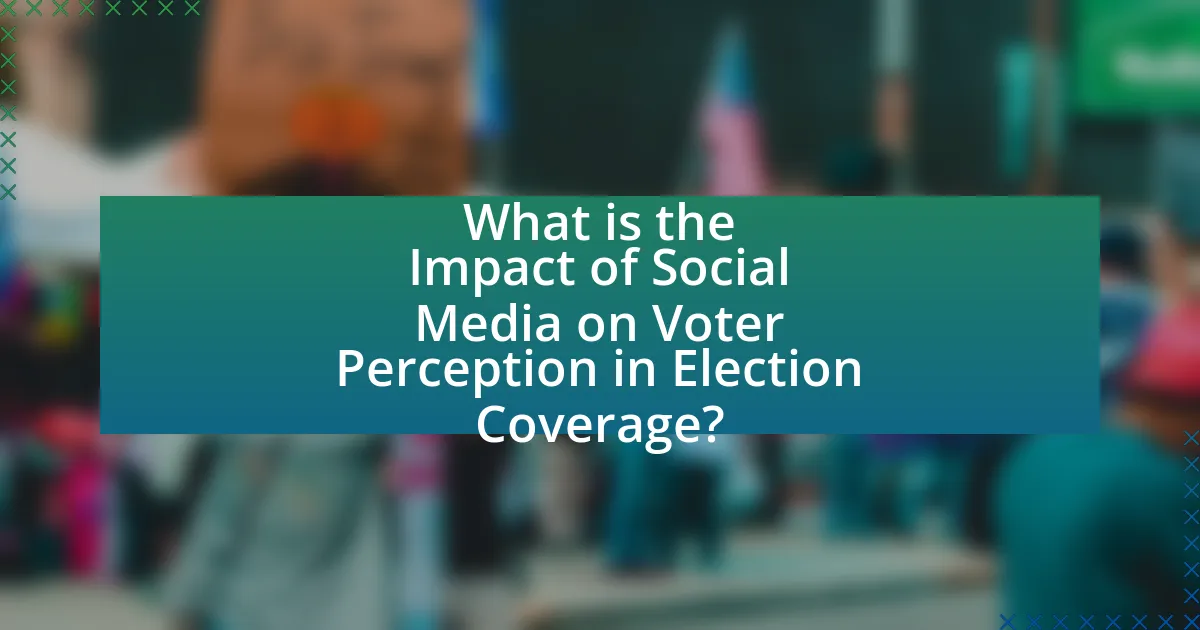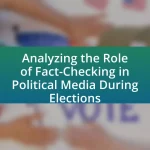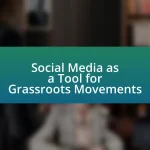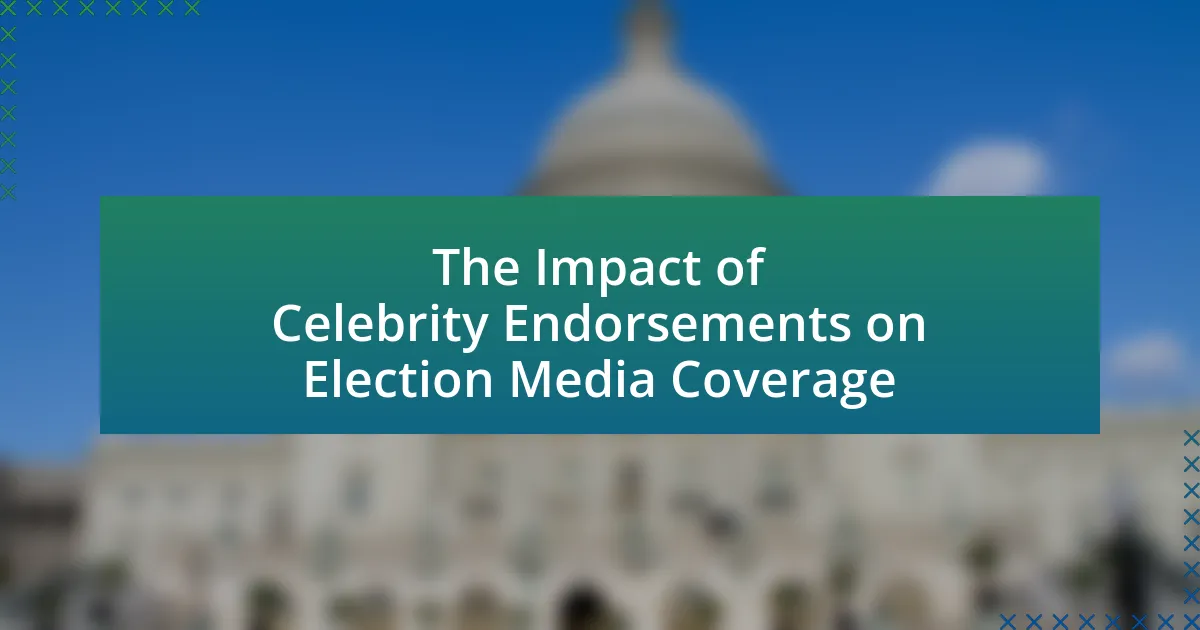The article examines the impact of social media on voter perception during election coverage, highlighting its role in shaping opinions, disseminating information, and creating echo chambers. It discusses how platforms like Facebook and Twitter serve as primary news sources for many voters, leading to biased perceptions due to algorithm-driven content prioritization. The article also addresses the spread of misinformation, the influence of targeted messaging on voter attitudes, and the importance of understanding voter perception for fair election coverage. Additionally, it outlines strategies to combat misinformation and emphasizes the need for voters to critically assess social media content to make informed decisions.

What is the Impact of Social Media on Voter Perception in Election Coverage?
Social media significantly influences voter perception in election coverage by shaping opinions, disseminating information rapidly, and creating echo chambers. Research indicates that platforms like Facebook and Twitter serve as primary sources of news for many voters, with 62% of U.S. adults obtaining political news from social media (Pew Research Center, 2020). This reliance on social media can lead to biased perceptions, as algorithms often prioritize content that aligns with users’ existing beliefs, reinforcing partisan divides. Furthermore, misinformation spreads quickly on these platforms, impacting voter attitudes and decisions, as evidenced by studies showing that false information can sway public opinion during elections.
How does social media influence voter opinions during elections?
Social media significantly influences voter opinions during elections by shaping perceptions through targeted information dissemination and engagement. Platforms like Facebook and Twitter allow political campaigns to reach specific demographics with tailored messages, which can sway undecided voters. Research from the Pew Research Center indicates that 69% of adults in the U.S. use social media, making it a crucial channel for political communication. Additionally, studies show that exposure to political content on social media can reinforce existing beliefs and create echo chambers, where users are primarily exposed to viewpoints that align with their own. This phenomenon can lead to increased polarization among voters, as highlighted in a study published in the journal “Political Communication,” which found that social media users are more likely to engage with content that confirms their biases.
What role does social media play in shaping political narratives?
Social media plays a crucial role in shaping political narratives by providing a platform for the rapid dissemination of information and opinions. This immediacy allows political messages to reach a wide audience quickly, influencing public perception and discourse. For instance, during the 2016 U.S. presidential election, platforms like Twitter and Facebook were instrumental in spreading both campaign messages and misinformation, significantly impacting voter opinions and behaviors. Research by the Pew Research Center indicates that 62% of U.S. adults get news from social media, highlighting its influence on shaping political narratives and voter perceptions.
How do social media platforms affect the dissemination of election information?
Social media platforms significantly influence the dissemination of election information by enabling rapid sharing and broad reach of content. These platforms allow users to access, share, and discuss election-related information instantly, which can lead to both increased awareness and the spread of misinformation. For instance, a study by the Pew Research Center found that 64% of Americans use social media to get news, highlighting its role as a primary source of information during elections. Additionally, algorithms on these platforms often prioritize sensational content, which can skew public perception and amplify partisan narratives. This dynamic creates a complex environment where accurate information competes with misleading content, ultimately shaping voter opinions and behaviors.
Why is understanding voter perception important in election coverage?
Understanding voter perception is crucial in election coverage because it shapes how candidates and issues are presented and interpreted by the public. Accurate representation of voter sentiment influences media narratives, which can sway undecided voters and reinforce the opinions of those already engaged. For instance, a study by the Pew Research Center found that 62% of voters reported that social media significantly impacted their views on candidates, highlighting the importance of understanding these perceptions to ensure fair and balanced coverage.
How does voter perception impact election outcomes?
Voter perception significantly impacts election outcomes by influencing how individuals evaluate candidates and their policies. Research indicates that perceptions shaped by social media can alter voter attitudes, leading to shifts in support for candidates. For instance, a study by the Pew Research Center found that 64% of Americans believe social media has a major impact on their political views, highlighting the role of online platforms in shaping public opinion. Additionally, during the 2016 U.S. presidential election, targeted social media campaigns were shown to effectively sway undecided voters, demonstrating the direct correlation between voter perception and electoral results.
What factors contribute to changes in voter perception during elections?
Changes in voter perception during elections are primarily influenced by social media, candidate messaging, and media coverage. Social media platforms facilitate rapid dissemination of information, allowing voters to engage with diverse viewpoints and narratives, which can shift their opinions. Candidate messaging, including campaign advertisements and public statements, directly impacts how voters perceive candidates’ qualifications and policies. Additionally, media coverage shapes public discourse by highlighting specific issues or controversies, further influencing voter attitudes. Research indicates that 62% of voters report that social media significantly affects their political opinions, underscoring its role in shaping perceptions during elections.
What are the key elements of social media’s impact on voter perception?
Social media significantly influences voter perception through information dissemination, engagement, and polarization. Information dissemination occurs as social media platforms allow rapid sharing of news, opinions, and campaign messages, shaping voters’ understanding of candidates and issues. Engagement is fostered through interactive features, enabling voters to participate in discussions, express opinions, and mobilize support, which can enhance their connection to political processes. Polarization arises as algorithms often promote content that aligns with users’ existing beliefs, leading to echo chambers that reinforce partisan views. Research by the Pew Research Center indicates that 64% of Americans believe social media has a significant impact on their political views, highlighting its role in shaping voter perception.
How do algorithms influence the information voters receive?
Algorithms significantly influence the information voters receive by determining which content is prioritized in their social media feeds. These algorithms analyze user behavior, preferences, and interactions to curate personalized content, often amplifying certain viewpoints while suppressing others. For instance, a study by the Pew Research Center found that 64% of Americans believe that social media platforms have a significant impact on their political views, highlighting the role of algorithms in shaping voter perception. By favoring sensational or engaging content, algorithms can create echo chambers, where voters are exposed predominantly to information that aligns with their existing beliefs, thereby affecting their decision-making processes during elections.
What types of content are most effective in shaping voter perception?
Visual content, such as infographics and videos, is most effective in shaping voter perception. Research indicates that visual elements capture attention more effectively than text alone, leading to higher engagement rates. For instance, a study by the Pew Research Center found that 64% of voters reported being influenced by videos on social media during elections, highlighting the impact of visual storytelling on voter attitudes. Additionally, emotionally charged content, including personal stories and testimonials, resonates strongly with voters, as it fosters a connection and enhances relatability, further influencing their perceptions.
How does misinformation on social media affect voter perception?
Misinformation on social media significantly distorts voter perception by shaping beliefs and attitudes based on false narratives. Studies indicate that exposure to misleading information can lead to increased polarization among voters, as individuals often align with content that confirms their pre-existing biases. For instance, a 2020 study published in the journal “Political Communication” found that misinformation can decrease trust in legitimate news sources, leading voters to rely on social media for information, which often lacks verification. This reliance on unverified content can result in misinformed voting decisions, ultimately impacting election outcomes.
What strategies can be employed to combat misinformation?
To combat misinformation, strategies such as fact-checking, media literacy education, and algorithmic transparency can be employed. Fact-checking organizations, like PolitiFact and Snopes, verify claims and provide accurate information, which helps counter false narratives. Media literacy education equips individuals with critical thinking skills to discern credible sources from unreliable ones, thereby reducing susceptibility to misinformation. Additionally, promoting algorithmic transparency in social media platforms allows users to understand how content is curated, enabling them to identify potential biases and misinformation more effectively. These strategies collectively enhance public awareness and foster a more informed electorate, crucial in the context of election coverage.
How do voters discern credible information from misinformation?
Voters discern credible information from misinformation by evaluating the source, cross-referencing facts, and analyzing the content’s consistency with established knowledge. Research indicates that individuals often rely on trusted news outlets and fact-checking organizations to verify claims, with studies showing that 60% of voters consult multiple sources before forming opinions. Additionally, cognitive biases, such as confirmation bias, can influence how voters interpret information, leading them to favor data that aligns with their pre-existing beliefs. This critical evaluation process is essential in the context of social media, where misinformation can spread rapidly, making it imperative for voters to engage in active information verification.
What are the implications of social media engagement for political campaigns?
Social media engagement significantly influences political campaigns by shaping voter perceptions and facilitating direct communication between candidates and constituents. This engagement allows campaigns to reach a broader audience, as platforms like Facebook and Twitter enable candidates to disseminate their messages quickly and interactively. For instance, a study by the Pew Research Center found that 69% of adults in the U.S. use social media, highlighting its potential reach. Furthermore, social media allows for real-time feedback and mobilization, as seen in the 2016 U.S. presidential election, where candidates utilized platforms to rally supporters and respond to opponents instantly. This dynamic interaction can enhance voter loyalty and influence public opinion, demonstrating the critical role of social media in modern political campaigning.
How do campaigns utilize social media to engage with voters?
Campaigns utilize social media to engage with voters by creating targeted content that resonates with specific demographics. This approach allows campaigns to communicate directly with potential voters, fostering a sense of community and involvement. For instance, during the 2020 U.S. presidential election, candidates used platforms like Twitter and Facebook to share updates, respond to voter inquiries, and promote events, resulting in increased voter interaction and mobilization. According to a study by the Pew Research Center, 69% of adults in the U.S. reported using social media, making it a crucial tool for campaigns to reach a broad audience effectively.
What metrics are used to measure social media impact on voter engagement?
Metrics used to measure social media impact on voter engagement include engagement rates, reach, impressions, sentiment analysis, and conversion rates. Engagement rates quantify interactions such as likes, shares, and comments, indicating how actively voters are participating with content. Reach measures the total number of unique users who see the content, while impressions count how many times the content is displayed, regardless of interaction. Sentiment analysis evaluates the emotional tone of social media conversations about candidates or issues, providing insight into voter attitudes. Conversion rates track the percentage of users who take a desired action, such as registering to vote or participating in a poll, after engaging with social media content. These metrics collectively provide a comprehensive view of how social media influences voter engagement.
How can voters critically assess social media content related to elections?
Voters can critically assess social media content related to elections by verifying the credibility of sources, analyzing the context of the information, and cross-referencing facts with reliable news outlets. Credible sources include established news organizations and verified accounts, which are less likely to spread misinformation. Analyzing context involves understanding the intent behind the content, such as whether it is meant to inform, persuade, or provoke. Cross-referencing facts with reliable news outlets helps confirm the accuracy of the information presented. Studies show that misinformation can significantly influence voter perception, making critical assessment essential for informed decision-making.
What best practices should voters follow to evaluate social media information?
Voters should verify the credibility of social media information by checking the source and cross-referencing facts with reputable news outlets. This practice is essential because misinformation can spread rapidly on social media platforms, influencing voter perceptions and decisions. According to a study by the Pew Research Center, 64% of Americans believe that fabricated news stories cause confusion about the basic facts of current events. Therefore, voters should look for established news organizations or fact-checking websites to confirm the accuracy of the information before accepting it as true. Additionally, voters should be cautious of sensational headlines and consider the context of the information presented, as misleading framing can distort understanding.
How can voters identify reliable sources of election coverage on social media?
Voters can identify reliable sources of election coverage on social media by verifying the credibility of the source, checking for factual accuracy, and assessing the presence of bias. Credible sources typically include established news organizations, academic institutions, and verified accounts of reputable journalists. Research indicates that 62% of voters rely on social media for news, making it essential to discern trustworthy information. Additionally, fact-checking websites, such as Snopes and FactCheck.org, provide verification of claims made in social media posts, helping voters distinguish between accurate reporting and misinformation.




